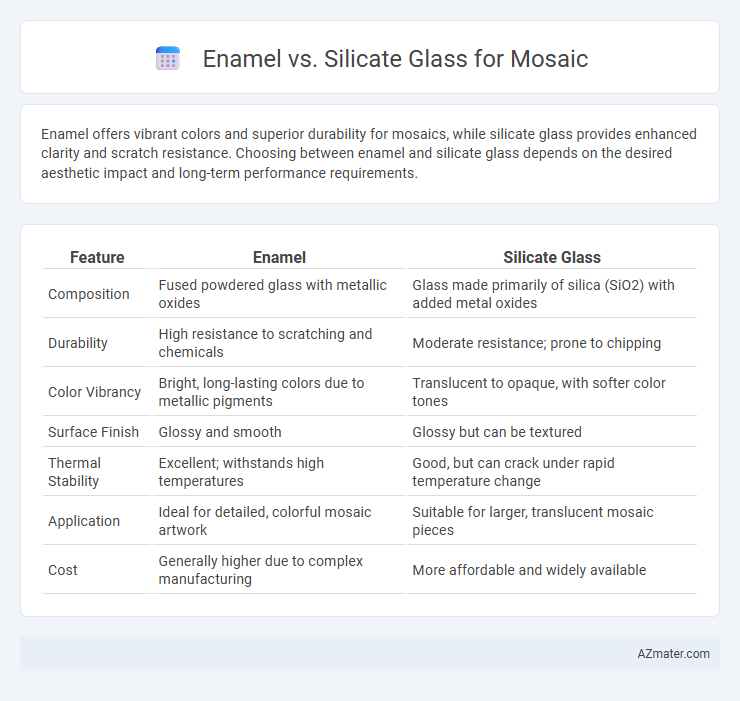Enamel offers vibrant colors and superior durability for mosaics, while silicate glass provides enhanced clarity and scratch resistance. Choosing between enamel and silicate glass depends on the desired aesthetic impact and long-term performance requirements.
Table of Comparison
| Feature | Enamel | Silicate Glass |
|---|---|---|
| Composition | Fused powdered glass with metallic oxides | Glass made primarily of silica (SiO2) with added metal oxides |
| Durability | High resistance to scratching and chemicals | Moderate resistance; prone to chipping |
| Color Vibrancy | Bright, long-lasting colors due to metallic pigments | Translucent to opaque, with softer color tones |
| Surface Finish | Glossy and smooth | Glossy but can be textured |
| Thermal Stability | Excellent; withstands high temperatures | Good, but can crack under rapid temperature change |
| Application | Ideal for detailed, colorful mosaic artwork | Suitable for larger, translucent mosaic pieces |
| Cost | Generally higher due to complex manufacturing | More affordable and widely available |
Introduction to Mosaic Materials
Enamel and silicate glass serve as foundational materials in mosaic art, each offering distinct properties that impact design and durability. Enamel glass, known for its vibrant colors and smooth finish, is fused at high temperatures, allowing for intricate and lasting decorative effects. Silicate glass, composed primarily of silica, provides a robust and translucent base ideal for creating detailed mosaics with natural light interplay and long-term resistance to weathering.
What is Enamel Glass?
Enamel glass is a type of glass treated with a finely ground, colored powdered glass fused onto its surface through high-temperature firing, resulting in a durable, vibrant, and glossy finish ideal for mosaics. This glass offers superior color intensity and resistance to fading compared to silicate glass, making it popular for detailed mosaic artwork requiring longevity. Its chemical composition includes silica, fluxes, and metal oxides that produce a range of vivid colors when melted and hardened, distinguishing it from the more common silicate glass used in mosaics.
What is Silicate Glass?
Silicate glass is a type of glass composed primarily of silica (silicon dioxide) combined with various metal oxides, which enhances its durability and resistance to heat and chemicals, making it ideal for mosaic art. Unlike enamel, which is a vitreous coating fused to metal, silicate glass is a solid glass material that can be cut into tiles or shapes for intricate mosaic designs. Its stability, vibrant colors, and smooth finish allow artists to create detailed and long-lasting mosaic artworks.
Composition Differences: Enamel vs Silicate Glass
Enamel glass for mosaics is primarily composed of finely ground glass fused with metal oxides, creating vibrant, opaque colors with a smooth, glossy surface. Silicate glass consists mainly of silica (silicon dioxide), combined with soda, lime, and other metal oxides, resulting in a more transparent and durable glass with a crystalline structure. The key compositional difference is enamel's inclusion of metal oxides for coloration and opacity, while silicate glass emphasizes clarity and strength through its high silica content.
Durability and Longevity Comparison
Enamel glass offers superior durability in mosaic art due to its resistance to scratches, fading, and chemical erosion, ensuring vibrant colors over time. Silicate glass, while slightly less robust, provides excellent longevity with natural weather resistance and high thermal stability, making it suitable for both indoor and outdoor installations. Choosing between enamel and silicate glass depends on the specific environmental conditions and desired lifespan for the mosaic project.
Color Range and Aesthetic Versatility
Enamel glass offers a vivid and extensive color range, making it ideal for vibrant mosaic designs with rich, intense hues. Silicate glass provides a more natural, muted palette that enhances aesthetic versatility by blending seamlessly into subtle or textured compositions. Both materials support a wide spectrum of artistic expression, but enamel glass excels in bold color saturation while silicate glass favors understated elegance.
Workability and Cutting Techniques
Enamel glass for mosaic work offers superior workability due to its consistent thickness and smooth surface, which allows for precise cutting and shaping with standard mosaic nippers or glass cutters. Silicate glass, while more brittle and prone to chipping, requires careful scoring and controlled snapping techniques to achieve clean edges, making it less forgiving for intricate designs. Choosing enamel glass enhances efficiency and accuracy in mosaic assembly, especially for detailed patterns requiring uniform tile sizes.
Cost and Availability Considerations
Enamel tiles for mosaics generally cost more due to their intricate manufacturing process and vibrant, durable finishes, while silicate glass tiles are more affordable and widely available in various sizes and colors. The availability of enamel tiles can be limited, often requiring special orders from niche suppliers, whereas silicate glass is mass-produced and commonly stocked by most tile retailers. Budget-conscious projects benefit from the broad accessibility and lower price point of silicate glass without sacrificing aesthetic versatility.
Best Applications for Each Glass Type
Enamel glass offers vibrant colors and durability, making it ideal for detailed mosaic art in interiors and decorative panels exposed to moderate wear. Silicate glass provides higher resistance to heat and chemicals, suited for mosaic installations in outdoor environments, kitchens, and bathrooms where longevity and easy maintenance are crucial. Choosing between enamel and silicate glass depends on the mosaic's exposure to elements and the desired color intensity for the project.
Choosing the Right Glass for Your Mosaic Project
Enamel glass offers vibrant colors and a smooth, glossy finish ideal for detailed mosaic art, while silicate glass provides enhanced durability and chemical resistance suitable for outdoor or high-traffic installations. When choosing between enamel and silicate glass, consider factors such as exposure to weather, desired color intensity, and the mosaic's functional environment to ensure longevity and aesthetic appeal. Opt for silicate glass for strength and resilience, or enamel glass for rich hues and smooth texture to match your mosaic project's specific needs.

Infographic: Enamel vs Silicate Glass for Mosaic
 azmater.com
azmater.com